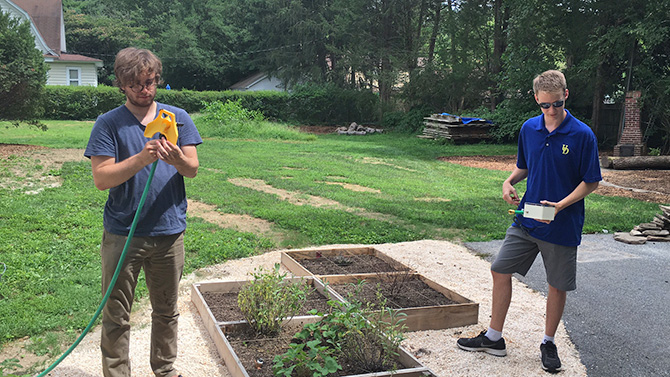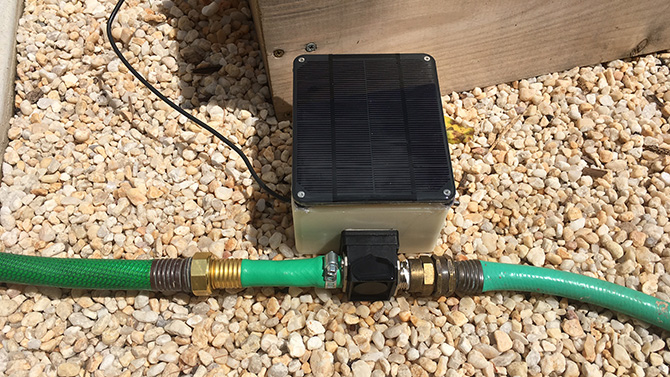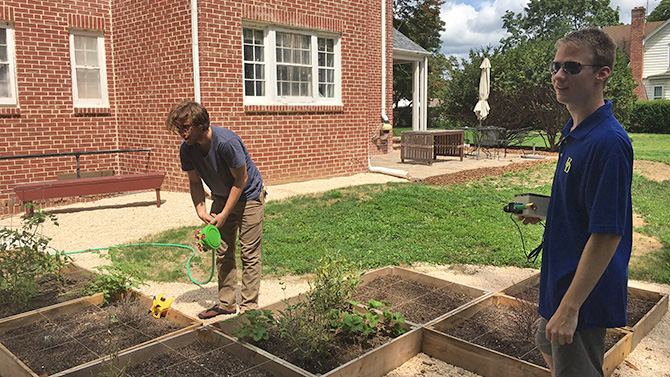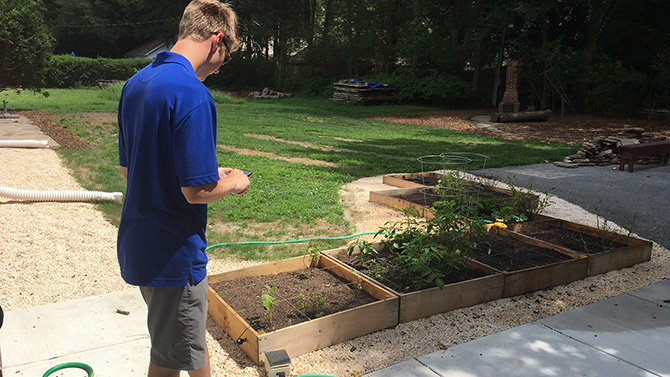

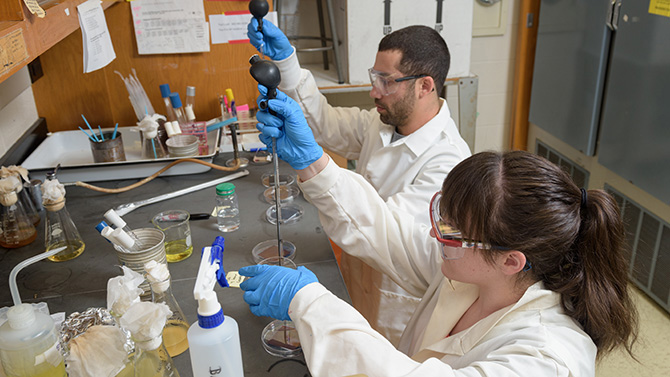
Entrepreneurship 101
Photo by Evan Krape August 31, 2016
Electrical engineering alum supports entrepreneurship through summer internships
According to an African proverb, it takes a village to raise a child.
It may also take a village to raise an entrepreneur.
This summer, four University of Delaware students had a small village helping them develop innovative ideas and assess the marketability of those ideas.
The citizens of that village included a Silicon Valley entrepreneur, a maker-minded mechanical engineering professor, two polymer scientists, a marketing strategist, a biology lab coordinator, a nursing instructor, and a team of infectious disease specialists.
Financial support and expert advisement for the four UD interns was provided by David Welch, who earned his bachelor’s degree in electrical engineering at UD in 1981 and went on to a career of entrepreneurial leadership in fiber optic communications.
The students worked in teams on the projects, with one developing a web-based smart gardening system to control watering and other plant care needs, and the other exploring applications for microbe-resistant polymers.
Smart gardening
Mechanical engineering major Trevor Stephens and electrical engineering major Ben Mazur partnered with John Welch, who is studying product design at Stanford University, on the smart garden system.
The team was initially challenged with integrating cameras into a new app, but they soon realized that the market was saturated, which of course is one of the foremost lessons in entrepreneurship.
Then their thoughts turned to smart home products like window blinds that respond to varying light conditions and thermostats that adapt to seasonal changes.
“We realized that we could take the same approach to gardening, where there was a limited number of products available, and most of them got poor reviews,” says Welch.
Using a small herb and vegetable garden in the backyard of adviser Dustyn Roberts as their testbed, the trio integrated moisture sensors, valves and actuators to create a smart watering system that’s connected to a cell phone. The module is the first in what they envision as a suite of modules that could be purchased separately to control, for example, nutrient delivery, pesticides, light, and humidity.
Not surprisingly, the students encountered a lot of “brick walls” during the 10-week project, including the challenge of getting disparate wireless systems to talk to each other.
But that’s a challenge on the technical side.
As Stephens says, “There’s a whole other side to this — you can’t just solve a problem that no one is worried about solving. We took a step back after we had our initial idea and talked to people that we thought might be interested. We learned that one of the reasons people stop gardening is they don’t have time to take care of things like watering and fertilizing.”
And then, even with market demonstrated, there’s another major hurdle faced by all budding entrepreneurs.
“Cost is an issue every step of the way,” says Mazur. “As much as you want to ignore it, you can’t.”
Microbe-resistant polymers
Caroline Koriakin and Andrew Trinker also learned an immediate lesson about entrepreneurship when they received their project assignment — the role of luck and chance in innovation.
In developing polymers for fuel cells, chemical engineering professor Yushan Yan had noticed something interesting — nothing was growing on them.
So he charged the two biomedical engineering majors with testing the materials against a variety of microbes, including Escherichia coli (e. coli), Methicillin-resistant Staphylococcus aureus (MRSA), and Staphylococcus epidermidis (S. epidermidis), an opportunistic pathogen that is the most common source of infections on embedded medical devices.
The students obtained promising results on the polymer’s resistance to S. epidermidis, and they got excited about the idea of applying it to artificial joints.
But they quickly realized that exploring such an ambitious application wasn’t a feasible goal for an undergraduate research project, so they turned their attention to applications like keyboard covers and touchscreen coatings, where there is a broad potential market, from day care centers and schools to nursing homes and hospitals.
The pair learned a lot about aseptic laboratory procedures, but they also received unexpected lessons about the nature of the research process.
“Everything took longer than we expected,” says Koriakin. “But it was also reassuring that every time we talked to our advisers, they said, ‘That’s just research. You’re doing great.’”
The Entrepreneurial Village
The following UD faculty members supported the work of the Welch Summer Interns in a variety of ways, from project definition and lab training to problem troubleshooting and market identification:
• Theresa Della-Volpe, lab coordinator, Department of Biological Sciences.
• Dan Freeman, director, Horn Program in Entrepreneurship.
• Christine Hoch, instructor, School of Nursing.
• John Rabolt, Karl W. and Renate Boer Professor, Department of Materials Science and Engineering.
• Dustyn Roberts, assistant professor of instruction, Department of Mechanical Engineering.
• Yushan Yan, Distinguished Engineering Professor, Department of Chemical and Biomolecular Engineering; associate dean for research and entrepreneurship, College of Engineering.
About David Welch
David Welch earned a bachelor’s degree in electrical engineering at UD in 1981 and then went on to complete his doctorate at Cornell University. Welch went to California after graduate school to join SDL, a leader in high power semiconductor lasers, as a research scientist in 1985.
After rising to the role of chief technical officer and vice president of corporate development at SDL, he identified, negotiated, and completed several corporate acquisitions, culminating in the merger of SDL with JDS Uniphase. In 2001, Welch co-founded Infinera, a manufacturer of optical telecommunications systems based in Sunnyvale, California. He currently serves as its president and sits on the board of directors.
Welch holds over 130 patents in optical transmission technologies, and he has authored more than 300 technical publications in the same field. A fellow of both the Optical Society of America and the Institute of Electrical and Electronics Engineers, he has been awarded the Adolph Lomb Medal, the Joseph Fraunhofer Award, and the John Tyndall Award in recognition of his technical contributions to the optical industry.
Welch has been a strong supporter of the College of Engineering and the Department of Electrical and Computer Engineering, particularly in terms of providing faculty resources. He is currently a member of the College of Engineering Advisory Council.
He was elected to the National Academy of Engineering in 2016 for his contributions to high-power semiconductor lasers and photonic integrated circuits.
SMART GARDEN PROJECT
Contact Us
Have a UDaily story idea?
Contact us at ocm@udel.edu
Members of the press
Contact us at 302-831-NEWS or visit the Media Relations website

